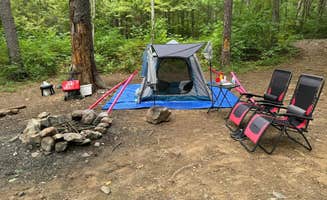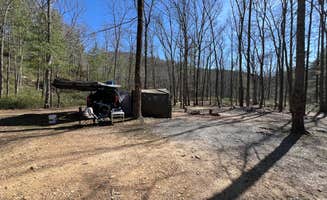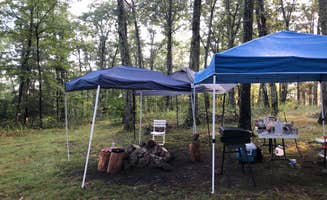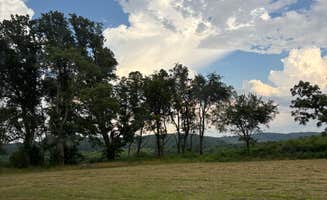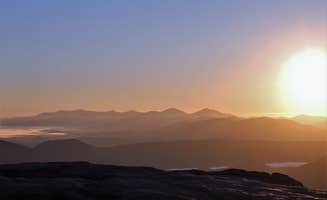Dispersed camping near Lynchburg, Virginia attracts outdoor enthusiasts to the Blue Ridge foothills, where elevations range from 700 to 3,000 feet throughout the surrounding national forest lands. Most primitive sites feature seasonal creeks that run strongest during spring and fall, while summer conditions can be hot and humid with temperatures regularly exceeding 85°F. Winter camping remains possible in lower elevations when forest roads aren't impacted by snow or ice.
What to do
Hiking to panoramic viewpoints: Spy Rock offers exceptional hiking opportunities with challenging terrain leading to substantial rewards. According to Emily T., "The hike up is brutal but the top is absolutely worth it" at Spy Rock. The trail features a small rock scramble before reaching 360-degree views of the Shenandoah Valley.
Creek fishing opportunities: The streams near Forest Road 812 provide catch-and-release fishing during warmer months. David B. notes that at Dispersed Camping Site off FR 812, there are "hiking trails and easy access to the stream" which makes it convenient for anglers to try their luck at small-mouth bass and trout fishing.
Day trip accessibility: Natural Bridge State Park sits approximately 20 minutes from many dispersed sites, offering ranger-led programs and interpretive trails. At Reservoir Road, campers appreciate the access despite some challenges. Derek D. mentions this site provides "Nice camping spots on the pedlar river in Amherst county" with "Multiple spots along reservoir rd."
What campers like
Solitude and privacy: Free camping near Lynchburg offers ample opportunity for secluded experiences away from crowds. As Mark M. describes at George Washington National Forest off 812: "There's access to the App Trail on the road so you might see some hikers but it was real quiet otherwise. Pretty nice scenery (you're smack in the middle of the forest) so if you want to get out and away from people this is a great site."
Established fire rings: Most dispersed sites include stone fire rings built by previous campers. Sawyer B. reported, "There was a fire ring and man made stone oven at the site we chose," highlighting the practical amenities at these primitive locations.
Creek-side camping: Many campers specifically seek water-adjacent sites for ambiance and practical needs. Kenlei B. shared their experience: "We had the absolute best time. It was so peaceful being by the creek and just relaxing. You are off the road of the national forest so cars come by but nobody bothers you and it stays quiet."
What you should know
Permit requirements: While many national forest sites are free without permits, the James River Wildlife Management Area requires a permit purchase. Zach K. explains, "You simply need to purchase either a daily or annual access pass from the DWR website and then report which days you will be staying at the WMA--it's currently $23 for the annual pass."
Site availability timing: Arriving early increases chances of securing preferred sites, especially during peak seasons. SJ W. observed that "80% were full on a beautiful fall Friday evening around 6pm but still snagged one" showing how timing affects site selection.
Navigation challenges: Forest roads can be difficult to navigate, particularly after rain. Ryan L. cautions, "It is a hilly drive down back roads off of 81. You loose cell service a couple miles from the site." Prepare with downloaded offline maps before entering remote areas.
Tips for camping with families
Multiple site options: For families needing space, Jon N. describes Dispersed Camping Site off FR 812: "It is a very rocky path, about 50 feet long, to get into the campground, but then it is smooth and well laid out. There is a giant fire circle in the middle and enough room to fit about 10 vehicles/groups if people don't mind being next to each other."
Road condition awareness: Access roads may challenge family vehicles without adequate clearance. SJ W. notes about Reservoir Road: "Went in August and it was very buggy, also had someone park pretty close which when I drive down a really long dirt road that is questionable for my van, i want it to be private and this was about 5 miles of dirt road to get to it."
Water filtration necessities: Families should bring adequate water or filtration systems as no potable water exists at sites. Keith H. mentions, "It was clean, creek for water if you have filter. Nice fire ring and wood," highlighting the need for proper water treatment equipment.
Tips from RVers
Size limitations: Most dispersed sites accommodate smaller trailers and campers rather than full-size RVs. L H. shares about James River Wildlife Management Area: "I was unsure if I was in the right area. I never saw another person camping... for me being in the 29 foot classy, I opted to park it in a field/parking area at the entrance. I was the only one here all day."
Leveling challenges: Many forest sites feature uneven terrain requiring leveling blocks or careful positioning. Though specific sites offer flatter areas, come prepared with leveling equipment for comfort.
Road clearance requirements: Forest Service roads demand vehicles with adequate ground clearance. Several reviews indicate passenger cars can access most areas during dry weather, but higher-clearance vehicles perform better, especially after rain events.


